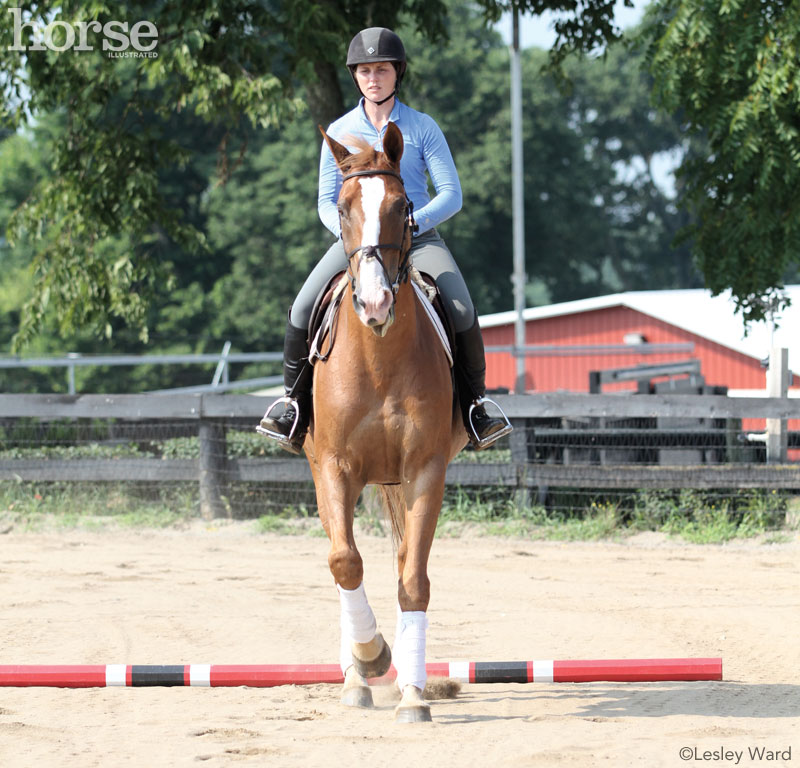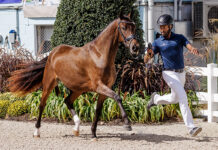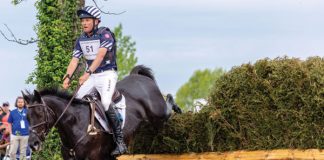
Ever wonder why sometimes you and your horse can’t quite put in a great round over jumps? Maybe the problem isn’t the jumps themselves, but rather your approaches to them. You can improve your ride to the jump by focusing on your flatwork.
“I use many, many different exercises in my clinics, but I feel the most valuable for any rider and horse are the simple ones on the flat or those incorporating very small obstacles,” she says.
While many riders come to her clinics expecting to jump challenging courses right from the start, often they must first demonstrate that they can master a course of ground poles. It’s not as easy as it sounds. Interspersed within the circles and looping turns are transitions and changes in pace and stride.
Linda Allen’s Exercise
To try a Linda Allen flatwork exercise, place two ground poles approximately 80 feet apart on the long side of your arena. Make sure you have plenty of room for circling between your ground poles and the arena rail.
Approach the first pole at a posting trot. Go over the pole and make a circle to the right—about 20 meters in diameter—that brings you back over the pole a second time. Now lengthen your horse’s stride at the trot until you are about 10 feet from the second ground pole. At that point, shorten your horse’s stride to a collected sitting trot as you go over the second pole. Again, create a circle to the right that comes back over that pole another time. Now, immediately after that pole, promptly transition upward to the canter. Make a smooth turn to the right, come back toward the middle of your line of poles, transition downward to a posting trot and repeat the exercise. This time, however, perform your circles to the left. You can raise the degree of difficulty by adding lateral movements such as leg yields and shoulders-in, simple or flying lead changes and halts.
By riding a challenging flatwork “course,” you’ll soon discover where your strengths and weaknesses are when you’re jumping. Do you allow your horse to arbitrarily alter his pace and length of stride? Are you a little lazy about maintaining a straight line? Does your horse bulge out or fall in on his turns and circles? If so, you need to fix it on the flat.
“The whole point of the exercise is accuracy,” Allen says. “Any exercise that involves many transitions, as well as lateral work performed with precision, will aid in creating real communication and cooperation between horse and rider.” And that, Allen promises, “leads to smooth, confident, and consistent performances over courses of fences.”
Further Reading
How to Help Your Horse Jump Better with Trot Poles
My Horse Won’t Jump in Both Directions
Jumping Tips







I think this is an excellent article, but the whole exercise will be frustrating to a green horse. If you are a novice rider on a green horse (which happens when you can’t afford a made horse) – take baby steps with this exercise so that neither you nor your horse gets frustrated. Set a small goal, accomplish it, pat your horse, say “good boy/girl” and move on to something more familiar. Next outing, add another movement, etc., etc…
I just discovered your website and am SO excited to explore it. I would be even more thrilled if you offered some kind of podcast, or at least a few audio recordings of the articles you have on the site. I cannot, of course, surf the internet at work, but I do listen to audio. I’d love to be feeding horsey-information into my brain all day! Thanks
Wow… I need that book. Always seems like when I’m on my own with no direction I’m at a loss what to work on. My mind goes blank, even after all the lessons I’ve had. I just need to keep that book on the rail and start with page 1! Great exercises with minimal equipment.
I have worked on a few exercises in the book with my best friend and it works! I need to get the book myself!!! =D And it’s simple exercises to really make you a better rider and go well with your horse in the saddle! ^_^
good info